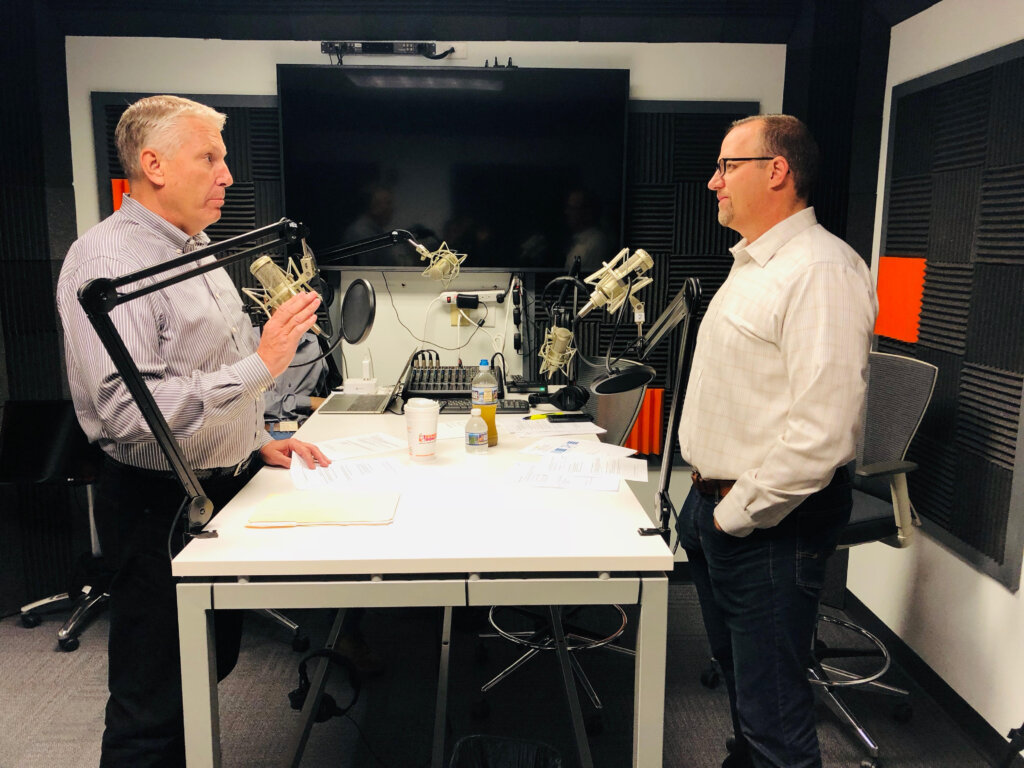Maxwell Executive Leadership Podcast #27: Leading Cross-Cultural Teams

We live in a cross-cultural, multicultural world where it’s common to have multiple national cultures represented on your team. It’s important to acknowledge that people from different cultural backgrounds have different expectations of what leadership looks like and to be aware of what’s going on with your team, clients, partners and vendors. In Episode #27 of our Executive Leadership Podcast, Chris Goede and Perry Holley will explore cultural intelligence (CQ), how you can develop it over time and become a stronger leader, overall.
Listen to all podcasts in this series and subscribe to new episodes on iTunes– or Google Play.
Read the transcript below:
Welcome to the John Maxwell Company Executive Leadership Podcast where our goal is to help you increase your level of influence, increase your reputation as a leader, and increase your ability to fully engage your team to drive remarkable results. Hi, I’m Perry Holley, a John Maxwell facilitator and coach and I’m Chris Goede, Vice President of The John Maxwell Company. Welcome and thank you for joining.
Today’s topic is Leading Cross-Cultural Teams. Perry, I know you’ve done a lot of work in this area. What’s the lesson for a leader in this topic today?
Wow. It’s just becoming more and more obvious. I wish I’d have known this so many years ago, but we really live in a cross-cultural, multicultural world. It’s easier now to travel, to migrate, to go live in another part of the world and America especially is a great place for people to want to come, and many companies are globalized. It’s very common now to have multiple national cultures represented on your team. And what I’m learning, I guess we’ve always known, but just for me, I didn’t pay attention to it: followers want to be led the way they want to be led and a lot of their expectations about what leadership looks like come from their national identity. And then I think as leaders, we rarely thought about how someone from a different cultural background than my own would want to be led.
You know, this goes back to some things that we’ve talked about, Perry, is that it’s so natural for us as leaders to lead people the way that we want to be led. Yeah. And I think that if you want to make great strides as a leader, I think you hit on the head, right? Like how do we begin to identify ways that we can lead everybody differently? In the past, we’ve talked about it from a personality standpoint. Today, obviously we’re going to talk about it from a culture standpoint. I saw a survey recently that said 90 percent of the C-Level executives identified cross-cultural leadership as one of their top management challenges. And as you had mentioned just a minute ago, you’ve been all over the world and I know you’ve done a ton of speaking and teaching and many, many different countries. Have you found this to be true?
Absolutely. It really opened my eyes speaking in different countries and getting to know different cultural orientations that what it takes to develop influence and really to be effective and culture is different. My own is you can lose influence in a quick hurry based on somebody else’s view of you. Most of us in the United States, I know we grew up with a monocultural world. The United States, while we do have different ethnic cultures within the national culture of America, in the European cultures, these are lots of countries. They’re not the United States of Europe. They are different countries, different cultures, different come froms. As the world has really flattened and businesses are really more global, it’s very common to either have people from different national cultures on your team that you interface with teams from other countries and all these I’m trying to influence and I’m trying to influence them from my cultural compass, right? I have to pay attention to some of their backgrounds. And not only is this an important conversation and topic about your team members, but I’d also challenge you with the mindset of a lot of us may not have different cultures on our team, but I promise you we do when it comes to our clients or partners as we call it at The John Maxwell Company or even our vendors. So much of a lot of people, the vendors are from, you know, different cultures. And I think that that is extremely, we need to have a heightened sense of awareness around that.
So you said national cultures. Are there other cultures than that? And I think I know the answer to this. Well, it’s interesting. There are many levels of culture and that’s interesting that you bring it up because it’s so easy to see or even an accent or in a physical look of see somebody’s nationality, not always, but you can often see national cultures, it’s most noticeable, but within our national culture there are going be ethnic cultures, racial cultures, religious cultures, political cultures. A generational culture, we just spoke about that on a recent podcast, a gender culture, so, this complex makeup of every individual you think really what makes us unique is that cultural makeup that comes in there. And so for a leader, how do I, you know, for me, I just looked at everybody the same. That’s a dangerous place to be as a leader. You have to really meet people where they are.
We’ve said this before, but leadership is hard and now you’re bringing something to us that I think it’s making it even harder. So I appreciate that. As leaders, we need to be aware of that. And that’s just what an individual brings to the table. Yeah. Right. So now you have me thinking, now we could tag onto that organizational culture and that plays a huge role, whether it’s from a functional culture with inside organizations, you can even break it down into the different functions as mentioned sales and marketing, finance and all these different cultures that I think we need to be aware of. And just reemphasize the fact that I just said that leadership is hard, but you know, this is really from a 5 Levels of tying this back to the 5 Levels. This is really a challenge for us as leaders at Level 2, you know, around the relationships. In order to get our team to a Level 3, you cannot skip Level 2. It is the foundation to all sustainability inside your team and you need to be aware of that. And in order for the team to produce results together and to build momentum, you have to start at Level 2 to get to Level 3. So here’s a question for you. With your experience, how would you coach a leader to address these cross cultural challenges? And just, I mean, at its simplest form, we could talk about this for a long time, but at its simplest form, how would you coach somebody in that?
I hope that this podcast will be a starting point. It’s just becoming aware, taking a step back and look at your team, look at your clients, look at your partners and just become aware of what’s going on there culturally. Also, self awareness, I’d probably start there. Self awareness would be about where do I come from, what are my identities and how I like to be lead. Things like that. And then that other’s awareness and become so rich to me is just stop thinking. Everybody’s like me because they’re not. You’d probably say thankfully, but this really opens the door to develop what’s now being called CQ, your cultural intelligence and that you can actually develop that over time and with awareness and a motivation to want to be a stronger leader and to lead all people in the way they want it to be led. And, that really comes down to dignity and respect for where they come from. You can really raise your level of cultural intelligence.
Okay, so I heard you say CQ, right? So we talk a lot about the IQ and the EQ part of leadership. And now for me, you’re introducing CQ. So what’s an example of having CQ? Yeah, cultural intelligence is key for a leader on how you communicate with people in your circle of influence. So we’re mentioning, we always talk about 360 leadership that, so, you know, up down and sideways in the organization, there’s a number of cultural dimensions. If you started looking into cultural intelligence and cultural orientations, there’s a number of dimensions that can be referenced. We don’t have nearly the time here to address that, but one cultural dimension that can affect a leader’s influences is your interaction style. How do you interact with others? So if you’re from North America like I am, you’re most likely to be somewhat on the direct side of that. We say what we think, we’re a pretty dogmatic about things. We just say it. We don’t avoid conflict, generally for most part it’s a cultural norm that we were pretty direct. But if you’re from a Latin America and actually most of the rest of the world have a very indirect communication style. They don’t embrace conflict direct. More straightforward, handles conflict. Straight on, emphasis is on my words.
But if I’m from another culture outside of North America, I might be more indirect, more subtle, more subdued. When handling conflict, the American might be perceived as being blunt or rude by the rest of the world. The Latin America the is emphasis on is on tone and not so much words. They could be perceived as being unclear. And we just say, why don’t you, to say what you’re thinking. And they say, why do you keep saying what you’re thinking? And it can be a real miss there.
In many European cultures, confrontation is a good thing. In most Asian cultures, confrontation is to be avoided. It’s called saving face. You would never want to confront someone because you might take some from them. You don’t want to do that, so you have to be quiet. And we think, why are the Asian people on my team not a telling me what I’m asking when their actually being true to their cultural come from and I’m not really respecting that.
Managing as you go through that and you kind of share that with us, a couple of things came to mind. It is so important as leaders to make sure that we keep an open mind, right? Because we talk a lot about in some of our coaching and our onsite training with people. When there is similarity in a person, specifically today culture, I think that there’s an immediate connection, but over time, because there’s similarity will probably have tension and we have to work through that and intentions good. It needs to happen and you can do that. When there’s a difference in the today culture, I think your natural reaction is to disconnect, right? As a leader, you immediately disconnect from them. And so I think it’s key that we keep an open mind. I think it’s key in an understanding and a kind of adapting to this that we have active listening skills on heightened awareness, a lot of us don’t listen well. And then really watch one of the things you said that kind of stuck out, really watch your nonverbal communication well big as your, especially when you’re going cross culture or as you have taught me today CQ. Well we talk about in leadership, you know, we’re talking about a Level 3 and Level 2, we talk about task oriented versus relationship oriented. Could this be a cultural deficit as well? Talk about that.
Absolutely. Well, a lot of the Anglo cultures, which would be the United States, Canada, United Kingdom, Australia, a lot of those cultures are just really task oriented. We just get right down to business. Many other cultures lean more toward relationships. So it could be the Latin culture, Latin Europe, Latin America, Middle Eastern cultures – very relational on how they do things, so they want to get to know each other before getting down to business. So I’ve been in many meetings right before I’m giving a talk or doing a workshop in a culture where I’m waiting to when are we going to talk about the actual task that we’re going to do and they’re spending all this time getting to know each other and having a coffee. I didn’t realize how important that was to them building a trust with me and being able to actually increase my influence, my ability to be more effective if I would just embrace what they’re trying to teach me from their culture.
Some cultures are about being about the individual that’s more of a US, North America where we’re about individual accomplishment. Many other cultures of the world are what we call collectivist, which is more about the group. It’s more about everybody crossing the line, not just me crossing the line. Some are about being more formal in North America, where many of the others are informal. Some about what really about time. This one’s kind of funny to me is a US culture, we’re very fixed or rigid. We go to a meeting, it starts on time. It has an agenda, ends on time, while others would be more what we call fluid. They’re not so punctual and we make fun of that. When II gave a speech in Mexico and 550 people. They said it’s the speech starts at 8:30 AM. I’m in the room at 7:30 AM making sure everything’s working, everything’s right. At 8:30 I’m the only one with 550 and three chairs. So I’m almost offended because you disrespected me and about, you know, 8:40 ish, they start wondering in, at 8:45, they’re getting a coffee and at 9:00 there they’re starting to get a buzz in the room. And then I realized, they’re not disrespecting me, they’re actually living to their cultural norms and I need to be a little more flexible. It’s really the word I get there. We’ll talk about it in a minute and being more adaptable.
Yeah, that’s a great word. You know, we talk about all of this driving employee engagement. I think the latest poll us all from Gallup was that a employee engagement is up to 32 percent, right? I think it went from 30 percent to 32 percent and so you look at that and you say, man, we got 68 percent of improvement to go and I think this is an area that would really help us, especially with the diversity of some of our organizations and clients or partners and or vendors. It brings me back to at the root of all of this for me, because I do have an natural Level 2 bent, and I’ve been developed and trained by John for so many years. You know, John says that people are going to buy into you. Yes. Right before they buy into the what or the vision or where we’re going. And so it’s so critical to your point, you mentioned about even just, hey, I need to slow down and have a cup of coffee with them before we go straight into what are we going to get done because you got to get them to buy into you. I think that that principle alone, right, is something that could do all of us well and serve and be a good service to us, no matter what the culture is, right? And make sure that they’re buying into you before what you’re asking them to do or what the agenda is for the meeting or keynote, whatever it might be. This is not a bunch of do’s and don’ts that we’re sharing with you today. Really, this is just an awareness thing that we wanted to bring to your attention and you said it best, Perry, when you said, really, we’ve got to figure out how do we adapt and really become self aware of where we’re at with the acknowledgement and the knowledge of different cultures.
If my motive is that I really want to gain influence with you to increase my leadership, my reputation as a leader, I want to drive employee engagement. I want to engage you at the highest levels of productivity that I need to find where you are and for me to just not be culturally responsible or even understand how can I adapt to you? One thing we talk about a lot is style. You know, I have a style, you have a style and whatever your cultural come from developed your style. That’s right. Can I shift my style to connect with you at at a more robust level?
Now a lot of questions we get, especially I get some Americans mostly as why should we always be adapting our style? Why do I have to change my style? I’m the leader. Why don’t you adapt your style to me? Well, really what are you trying to accomplish? What’s your outcome you want here is that I could be a Level 1 leader and just tell you to do it or I could really want to connect with you and develop a relationship with you so I can produce results for you, equip you and develop you to my next generation of leaders. And it really to me kind of sums it all up, is that there are certain things I may not shift on. I had a guy, he wanted to go to a Voodoo expedition exhibition and I said, I want to be supportive, I want to be a team player, but that goes against a core belief of mine and I’m just going to have to not flex on that. So I excused myself politely and he respected that. But, you know, speaking in Latin America, can I flex and do my speech at nine instead of 8:30? Absolutely. It’s a cultural norm for them. It’s not a core belief to me just when I wanted to start. So you kind of decide when can you adapt and when you stick with your core belief and when do you actually adapt to their belief and help drive that connection.
Well, I think we could unpack this for a long time. It’s a big subject and we could break down a lot of different cultures that you’ve kind of raised. But as we wrap up today, just given everybody’s kind of introduction, what call to action would you have for us?
Yeah, I’ll tell you really probably bring back another podcast at a later time on bias, unconscious bias. It’s big talk in the leadership world today about how we’re driven a lot of our behaviors and the behaviors of our people are driven by biases that we have. That’s not a bad thing. We all have them, but could I be that self awareness? What are my cultural orientations and my bias. Second that being others aware, be intentional about the cultural makeup of the people on your team. It can be complex, but just the more you learn that relationship level to the more you get to know them. And what drives them, what motivates them is such a key thing to knowing what makes people tick. A third, I would try to figure out where I can adapt my communication style for maximum effectiveness and that’s that flexing when I need to flex.
And one of the warnings I would give you is be careful not to stereotype. That’s a real danger zone here that says well, all French people are this way, or all people from Mexico that way, that’s never, never true. So all Americans are this when they go to Europe. No, they’re not. You may be a stereotype, but don’t do that. Everybody’s an individual and everybody is a unique and part of your leadership job is to get to know your people so that you can engage them at the highest levels.
Yeah. If we will, except, and understand the differences are a multicultural team, don’t stereotype. But if we will understand the differences, then we can use that to enhance the way the team analyzes situations and makes decisions in order to be more productive for the organization. And I think that’s our challenge, right? If we can accept and understand, we can use that collectively to be betterment for the organization. Well, great stuff. Perry, thanks for bringing this topic to us. I can obviously tell you’re very passionate about it. You’re a lifelong avid learner and this is what Perry’s learning about right now, and he wanted to share that with you.
Also, as a reminder, if you would like to learn more about the 5 Levels of Leadership or perhaps bring a 5 Levels of Leadership Workshop to your organization, please go to JohnMaxwellCompany.com/podcasts. We would also welcome any questions or thoughts you may have about leadership on that site that Perry and I will be able to answer in future podcasts for you. Thank you for joining us. This has been the John Maxwell Company Executive Leadership Podcast.












Be the first to comment on "Maxwell Executive Leadership Podcast #27: Leading Cross-Cultural Teams"